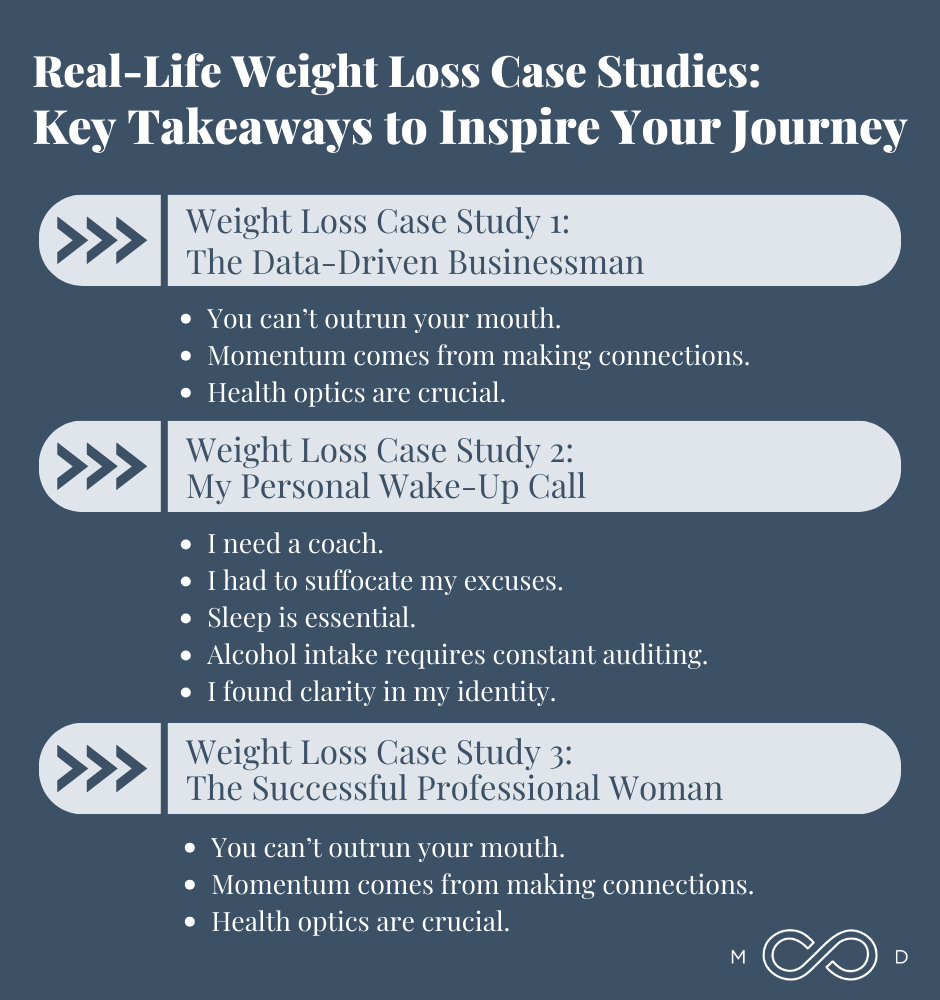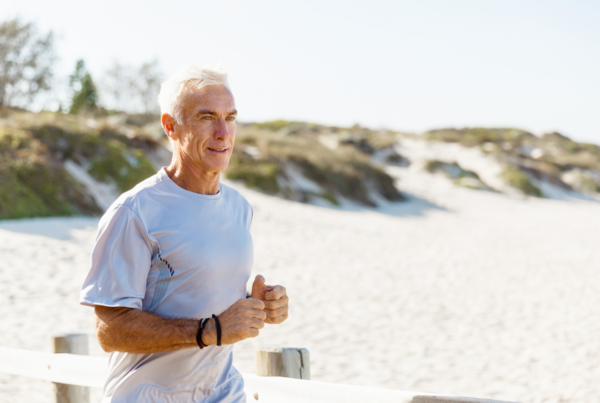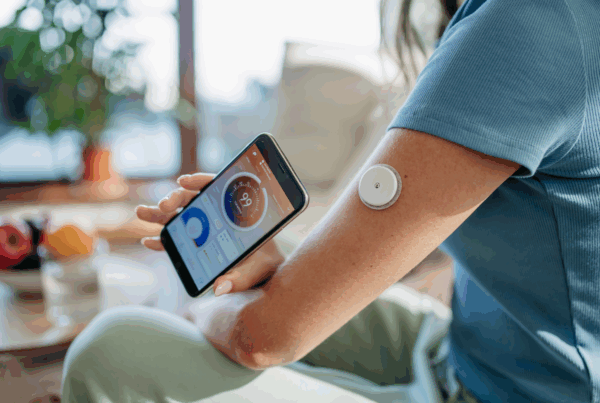Download file | Play in new window | |
Both now and in the past, I’ve dedicated my career to helping people achieve optimal health. Few areas of medicine have captured my attention and passion more than metabolic health.
Over the years, Jen (Brentwood’s nurse practitioner extraordinaire) and I have worked with hundreds of patients struggling with weight issues, insulin resistance, and metabolic syndrome. Addressing these is a deeply personal and often frustrating journey. And no two stories are exactly alike.
Today, I want to share three powerful weight loss case studies — including my own personal experience. Each is unique, but the lessons they offer are universal. If you’ve ever felt stuck, overwhelmed, or just plain fed up with the weight loss roller coaster, these stories might provide the inspiration or insight you need.
Weight Loss Case Study 1: The Data-Driven Businessman
One of our most inspiring stories is a 56-year-old successful businessman who had struggled with weight his entire life. His dynamic, take-charge attitude meant he could successfully follow a diet to lose weight, but when the diet ended, the weight returned (and then some).
With a history of heart disease and type 2 diabetes and a Cleerly scan that revealed concerning arterial plaque, his health was on a downward spiral. When we first met, his weight had climbed past 300 pounds, his visceral (belly) fat was increasing, and he began experiencing chest pain and shortness of breath.
He needed a change, and he needed it soon.
The Breakthrough
When talking with Jen, he insisted he was eating “clean” and around 1,600 to 1,800 calories per day while also walking 20,000 steps, but she realized something didn’t add up. “If I asked you how much money your business made last year, could you tell me to the penny?” she asked.
“Oh yeah,” he replied.
“You wouldn’t say ‘about 10 million?’”
“No.”
“Great. So then you can’t tell me ‘about’ 1,600 to 1,800 calories, either.”
That hit home. Reluctantly, he started journaling his food and quickly realized he was consuming far more than he thought. Just three days later, he texted with a revelation: “My breakfast alone is 600 calories.” Once he had exact numbers, he was able to optimize his diet to produce a tighter calorie deficit.
Alongside food journaling, a continuous glucose monitor (CGM) gave him real-time insights into how specific foods affected his blood glucose. As a data-driven person, he loved this consistent, objective feedback, which created a powerful connection between his food choices and his body’s biochemical response.
We also optimized his testosterone levels through pellet therapy after previous methods hadn’t worked well for him. Within six months, he lost over 80 pounds, normalized his blood glucose, and was working out four to five times per week. He came to appointments glowing with a new lease on life, and for good reason; he had completely changed his health trajectory.
Lessons Learned
This member’s weight loss case study provided several key lessons:
You can’t outrun your mouth. Many people believe they can exercise away poor nutrition choices. For him, this wasn’t true. Despite walking 20,000 steps daily, his weight continued to increase while causing substantial physical ailments like knee pain, back pain, and more.
Momentum comes from making connections. Once he linked his CGM data with his nutritional tracking, he understood exactly which foods benefited or harmed his unique physiology.
Health optics are crucial. We built him a personal health dashboard to provide daily metrics on blood sugar, caloric intake, energy output, and more. This data gave him the ability to exercise control over his health in much the same way he would exercise control in his business.
This member not only experienced success but also deeply understood why he was succeeding — a powerful ingredient for long-lasting results.
Weight Loss Case Study 2: My Personal Wake-Up Call
For most of my life, I identified as athletic. I played sports, stayed active, and never struggled with weight. That all changed around age 40, when my life circumstances changed dramatically.
During a five-year period, I finished residency, started working night shifts at the emergency, grew my family, and began navigating entrepreneurship. I stopped lifting weights because I simply didn’t have time. My emotional and decision-making reserves were drained, leaving little energy for making good food choices.
The result? I gained 44 pounds of fat. What’s interesting is my scale only showed a 17-pound weight gain. I didn’t realize that this “moderate” gain masked a dramatic loss of lean mass combined with a profound accumulation of adipose tissue.
I became a walking poster child for metabolic syndrome, developing hypertension, insulin resistance, and truncal obesity. And I was stuck.
The Breakthrough
One afternoon, I was watching an ESPN special about Tom Brady. Discussing the off-season, Brady mentioned spending significant time with his throwing coach. I had to stop the video and rewind. Why was a multi-time Super Bowl champion still working with a throwing coach? What could a throwing coach possibly teach him at this stage?
Then it hit me: If Tom Brady needs a throwing coach, why did I think I could figure everything out on my own?
Looking back on my life, I realized I’d always had mentors — people I admired who pointed out blind spots and offered guidance. As an athlete, a student, and a soldier, I’d always had a “coach.” But as an adult, father, husband, and business owner, I no longer had anyone speaking into my life.
Within 30 days, I installed a home gym, hired a trainer, and began therapy for the first time, continuing for nine months.
This was a turning point for me. I refer to it as the moment I fired “Fat Aaron” — a five-year version of me many of my current friends have never met.
Lessons Learned
I’m still on this journey, but I’ve made so much progress since the days of Fat Aaron. Here are a handful of lessons I took away from that time:
I need a coach constantly in my life to point out blind spots. Despite striving for high self-awareness, I’m only aware of what I can see. Having someone mirror back to me what I’m missing is invaluable.
I had to suffocate my excuses. Yes, I was busy. But that didn’t mean my body would forgive me for ignoring it. Taking full responsibility for everything freed me from being paralyzed by escape hatches.
Sleep is essential. During those years, I grossly underestimated the impact of neglecting sleep. Of the top three health pillars (nutrition, exercise, and sleep), sleep has become my number one health priority.
Alcohol intake requires constant auditing. The impact of alcohol is vastly underrated, not simply because of empty calories but because of its effects on so many other health factors. I didn’t give up alcohol, but I realized it’s easy for alcohol consumption to get away from you over time. So, if I’m going to consume it at all, I have to keep it under ongoing review.
I found clarity in my identity. Understanding who I am, who I believe I was created to be, and who I want to become fundamentally shapes my every decision and behavior. Once I got this clarity, it became obvious to me which behaviors to double down on and which to eliminate.
Weight Loss Case Study 3: The Successful Professional Woman
Our third case is a 44-year-old professional woman who joined our practice two years ago. As a younger woman, she’d been fit, active, and athletic. Now, as a driven, high-performing professional, she was at her maximum state of confusion, overwhelm, and weight-loss fatigue.
When she joined us, she weighed 185 pounds and had a wedding on the horizon. She had “tried everything” with minimal results. The pressure was on.
The Breakthrough
We reframed her setbacks using an analogy from golf, a sport she’d recently taken up. Like many golfers, she’d have a few great holes, followed by a disastrous blow-up hole that ruined her score. Similarly, in weight loss, she’d eat well for days, then one indulgence would spiral into a bad week.
She saw that she needed to stop carrying those “blow-up holes” into the next meal. Instead of letting one bad meal derail an entire day or week, she learned to reset immediately — just like in golf.
We also addressed her subclinical hypothyroidism and recommended starting a GLP-1 agonist medication (Zepbound) to help with weight loss. She was initially hesitant but agreed to give it a try.
In three months, she lost 25 pounds, consistently losing about 2 to 2.5 pounds weekly. When she hit a plateau, we added a continuous glucose monitor to provide data on how her food choices affected her blood sugar levels.
This final addition fully unlocked results. She went from 185 to 125 pounds in less than six months, proving to herself that she could do hard, scary things. Now at her goal weight, she’s exploring how to maintain her weight without medication support.
Lessons Learned
Treat setbacks as isolated events. If you slip up, it doesn’t have to ruin the day, the week, or the whole journey. It’s just one mistake. Don’t let it snowball.
Curiosity is better than judgment. Rather than judging her struggles, we helped her get curious about her situation and the available tools and paths to push forward.
Aim for courage and consistency. Embracing new approaches requires courage after past efforts never delivered. “Less think, more do” became a crucial mantra, as overthinking had kept her from success for years.
How Our Thinking About Weight Loss Has Changed
For years, we believed what we were taught: Weight loss is as simple as “eat less, move more.” After working with so many patients, our perspective has shifted. While calories do matter, that old advice simply doesn’t work for everyone.
The science on weight loss has evolved. We now know how important blood sugar management is, and tools like continuous glucose monitors prove that 500 calories of candy bars don’t have the same effect as 500 calories of broccoli. New tools like GLP-1 agonists and personalized hormone therapies offer previously unavailable paths to weight loss and metabolic recovery.
There is no one-size-fits-all approach, and results take time. Each weight loss case study presented here involved long-term struggles requiring months or years to resolve. Weight management is complex, involving emotional, physical, biochemical, and sometimes spiritual elements.
Each person’s weight loss journey is unique, and the right strategy will be tailored to their biology, lifestyle, and mindset.
What We Wish Everyone Knew About Weight Loss: Case Study Lessons
If Jen could give just one piece of weight loss advice, it would be this: Never, ever give up.
Weight loss is rarely a straight path. It’s a journey of trial, error, and adjustment. Some people need medication, some need therapy, some need rigorous tracking — but everyone needs patience and persistence.
Consistency beats perfection every time. Small daily improvements compound over days and months, leading to real, lasting change.
Perhaps most importantly, we want everyone to find their team. Whether it’s a coach, a doctor, a therapist, or a supportive friend, no one succeeds alone.
If you’re struggling, keep going. With the right support, you can find the breakthrough you need.
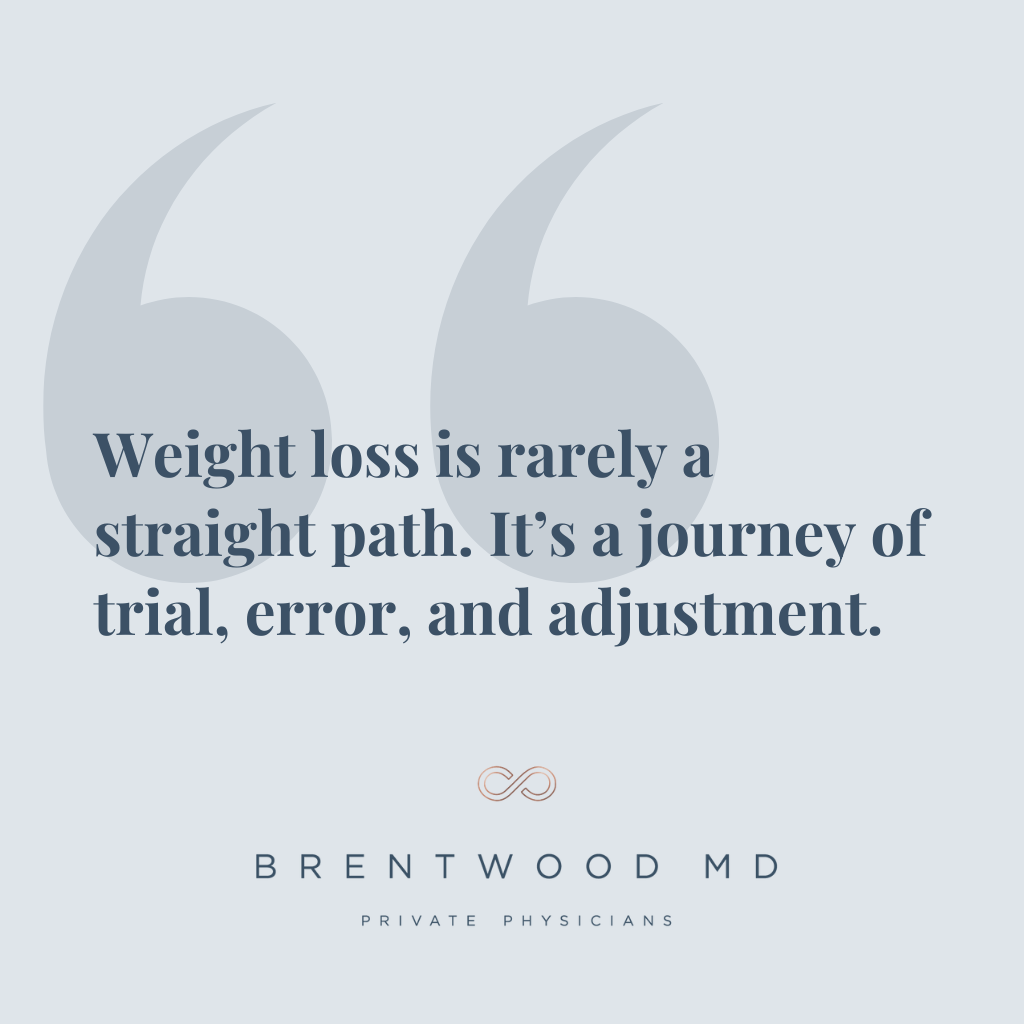
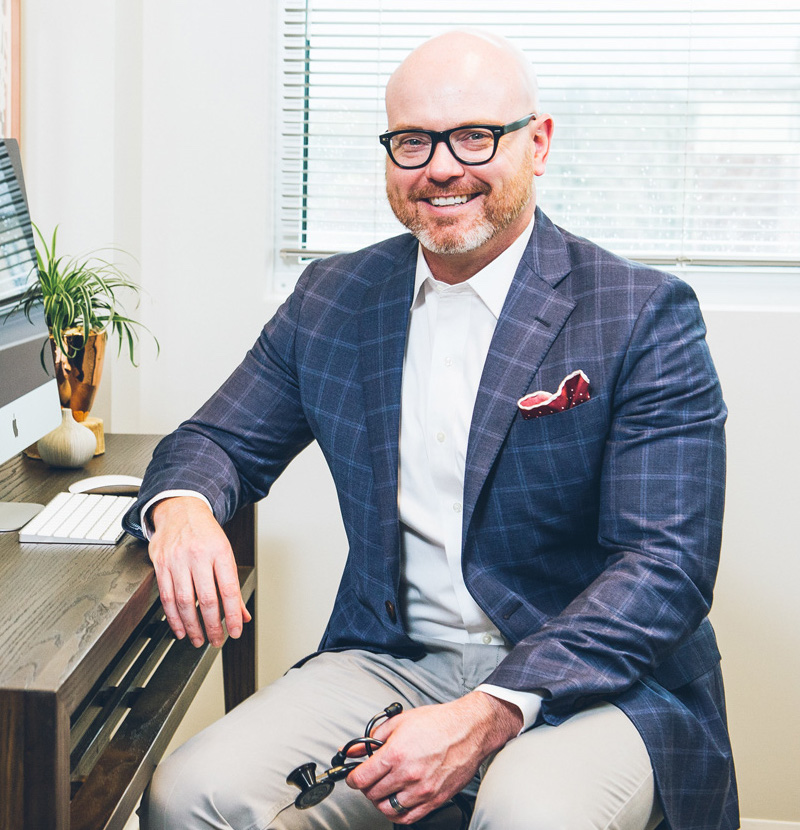
Dr. Aaron Wenzel is a concierge physician specializing in the care of fast-moving entrepreneurs, executives, and public figures in the Nashville, TN area. Dr. Wenzel’s diverse life experience and extensive training in family medicine, emergency care, nutrition, and hormone replacement therapies give him the unique platform to provide unmatched care for his patients.




